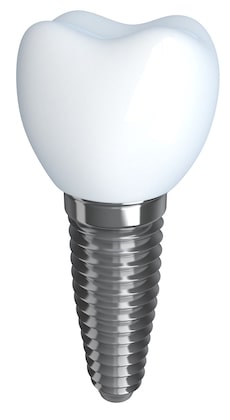
Patients who lose any of their teeth due to a dental issue or an accident/trauma to the mouth often visit a cosmetic dentist to have a dental implant placed in the area with the missing tooth. A dental implant is the insertion of an artificial tooth root that bonds with the jawbone. They look, function, and feel like natural teeth and help to give the mouth a look that is healthy and does not have the appearance of any missing teeth.
Interested in learning more about how dental implants improve the look and function of the mouth? Read on to learn more in this informative article.
Dental implants are placed during outpatient surgery, and they are made of titanium, as well as other materials, that fuse to the jawbone in order to imitate a tooth root. The artificial root enables dentists to secure the replacement teeth, so they remain stable in the mouth while blending in with the existing teeth.
Patients who have dental implants placed in the mouth will need to visit the doctor for several appointments to complete the process. Children should not have the procedure until the development and growth of their jaw is complete.
An ideal dental implant candidate needs to have a sufficient amount of bone tissue located in the jaw in order for the dental implant to properly fuse to the natural bone in the mouth. If the person does not have a sufficient amount of bone tissue, a bone graft can be placed in the mouth to better secure the dental implant.
 In general, a dental implant can replace teeth that have been damaged or lost due to gum disease, an infection, or tooth decay. The process starts with a consultation appointment where the dentist will determine if the patient is an ideal candidate for the procedure.
In general, a dental implant can replace teeth that have been damaged or lost due to gum disease, an infection, or tooth decay. The process starts with a consultation appointment where the dentist will determine if the patient is an ideal candidate for the procedure.
While it is possible to have both a dental implant and a dental crown placed in the mouth on the same day. It is more common for the dental implant procedure to be performed during multiple appointments.
The first step of the process begins with the dentist making an incision in the gums in order to place the dental implant into the jawbone. Once the implant is in the designated place, the dentist will close the gums over the dental implant. A few months later, the patient will return to the office of the dentist once the bone has grown around the implant so it will remain in place (as the titanium combines with the bone).
Once the dentist is sure that the dental implant is securely in place, an abutment will be placed over the post of the implant, and it will hold the new tooth for the patient. Once the gums have healed, the dentist makes an impression of the tooth in order to create a crown (which is a custom replacement tooth). The crown will be attached to the abutment that is in the mouth.
Once the dental implant is in place, the patient will feel some pain as well as experience some swelling, bruising, and minor bleeding. During the healing process, the patient will need to eat food that is soft, and any pain can be treated using an over-the-counter pain medication.
The dental implant results can be seen almost immediately after they are placed in the mouth. If the patient practices proper oral hygiene, the implants can generally last anywhere from five to fifteen years. Even though proper oral hygiene can help maintain the results, there is a chance of gum disease occurring if regular follow-up appointments and ongoing brushing and flossing are not performed. Keep in mind that dental implants do not experience tooth decay, but they can be impacted by periodontal disease.
Patients who are interested in having dental implants in the mouth should schedule a consultation appointment with a dentist who is experienced in placing dental implants in the mouth. The dentist can examine the mouth of the patient to determine the current condition of the teeth and to see if any of the teeth need to be removed so an implant can be put in its place in the mouth.
As mentioned above, dental implants are able to replicate the look and feel of natural teeth in the mouth and also improve the functionality of the teeth. The improvement of the look and functionality of the teeth can improve the self-image of the patient and make them less self-conscious about others being able to view their teeth during a smile. Since dental implants remain in place and preserve the alignment of the teeth, patients are encouraged to learn more about this cosmetic dentistry procedure from their dentist of choice.
- MA